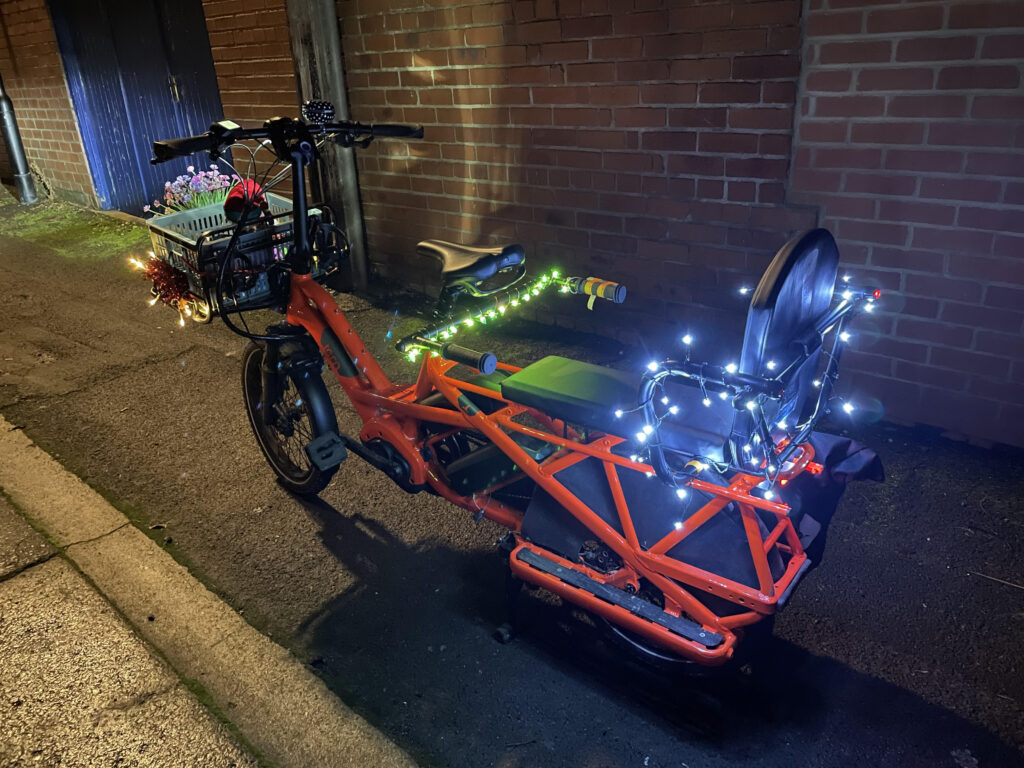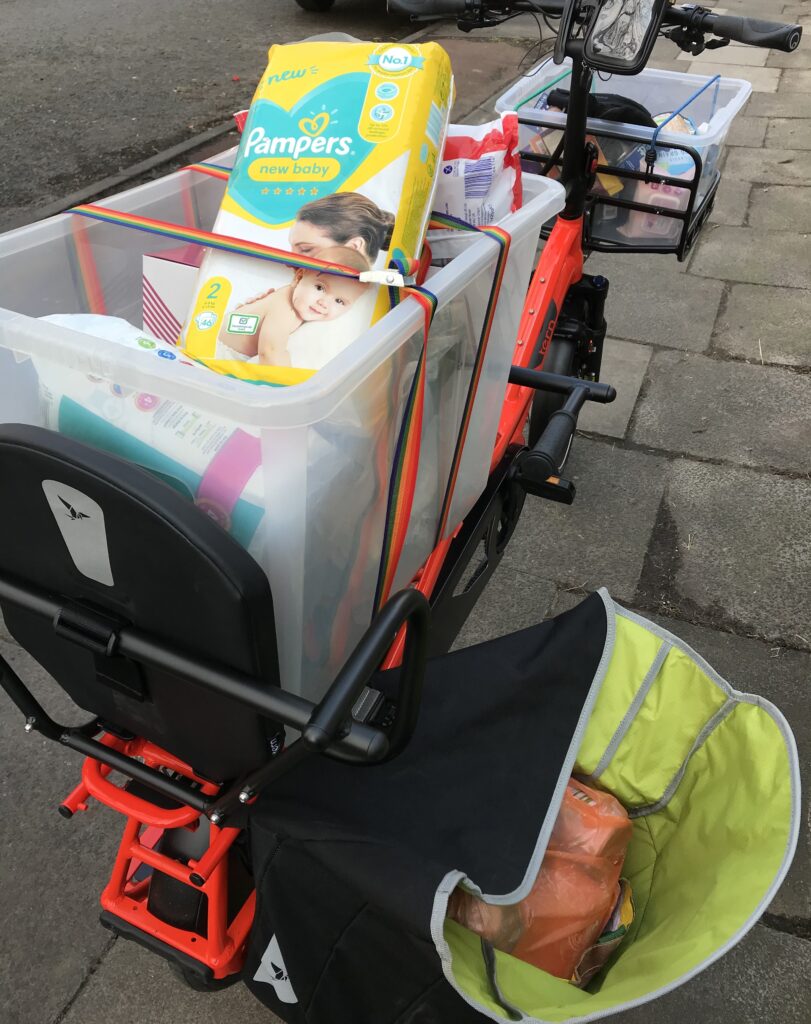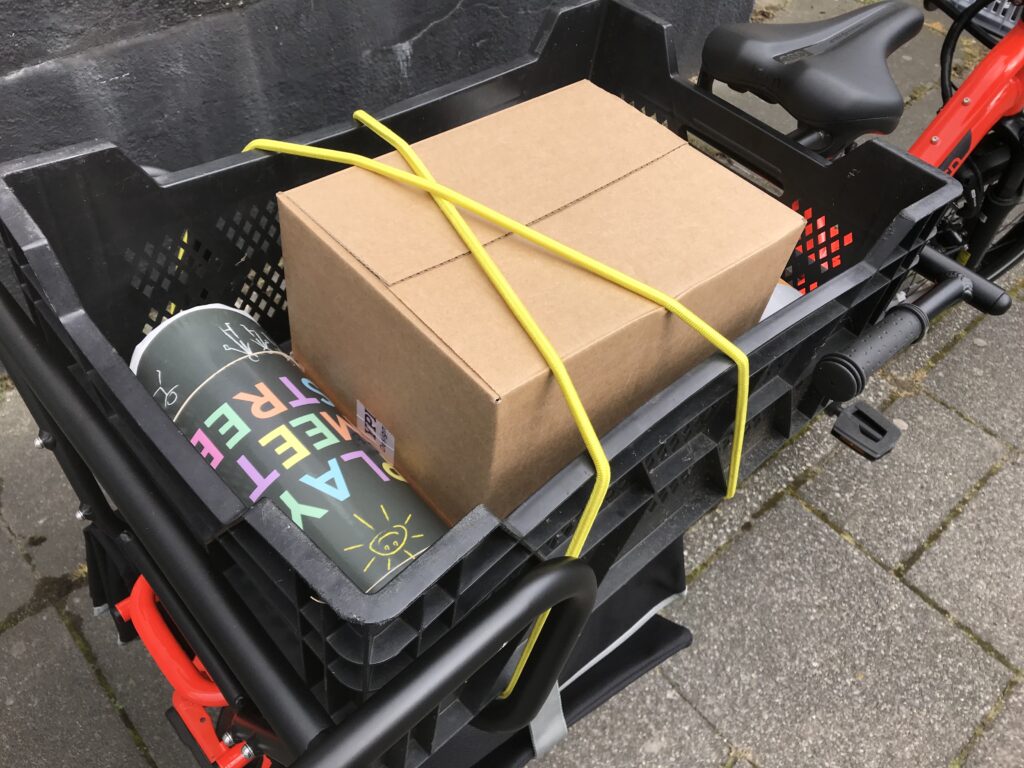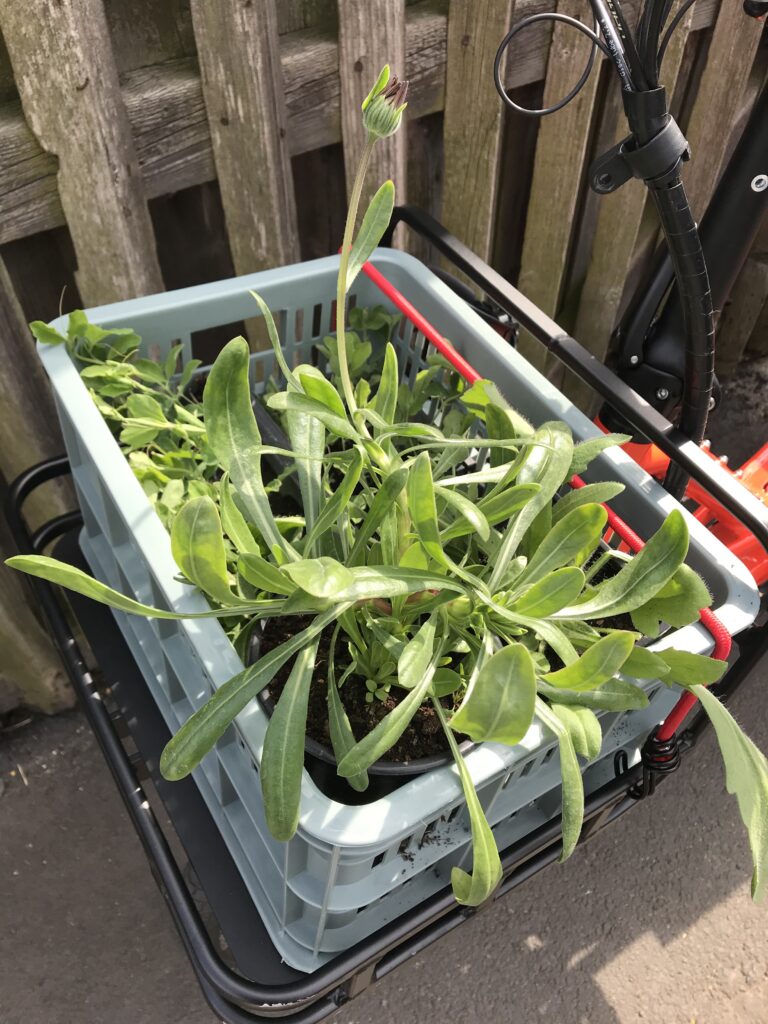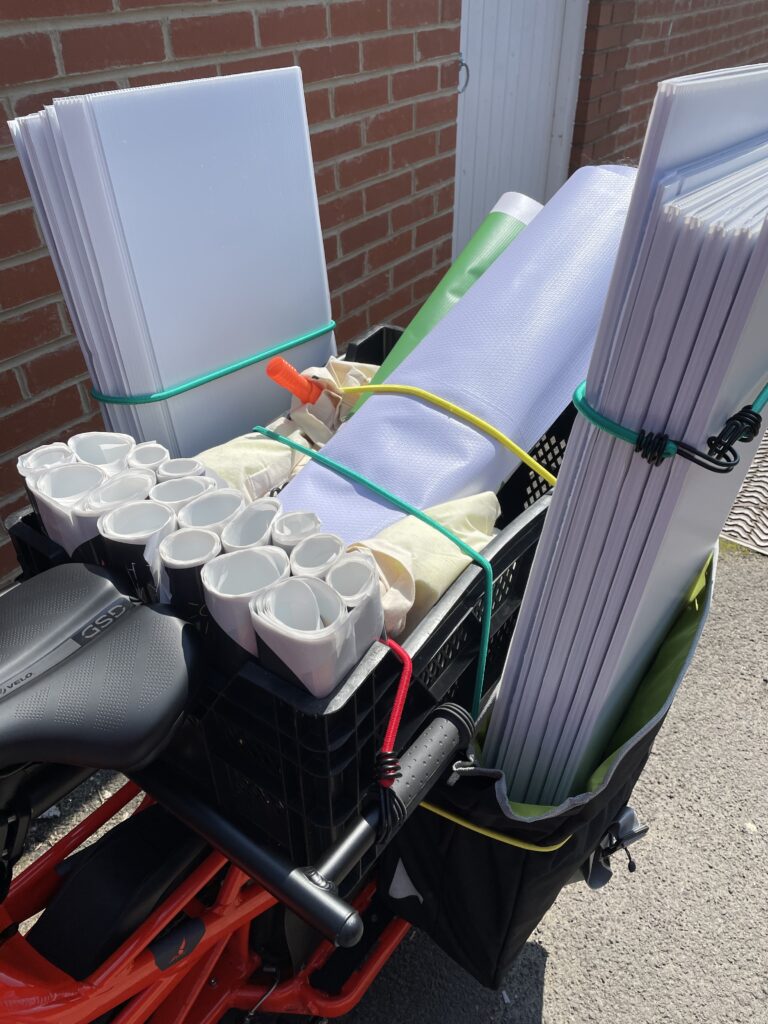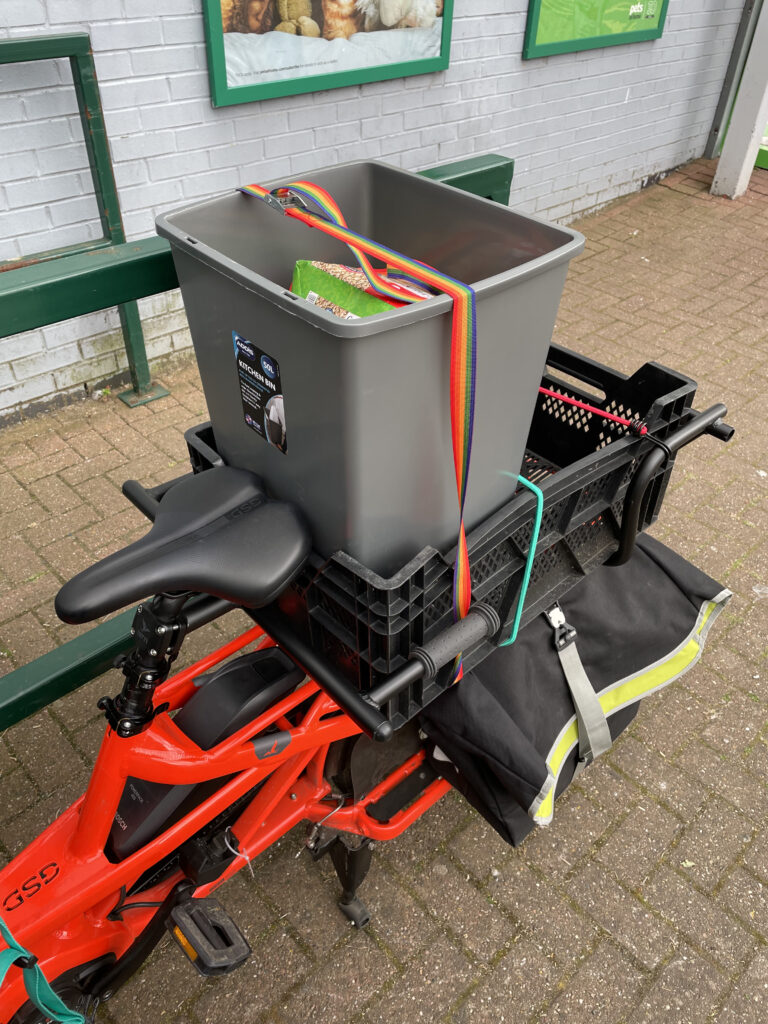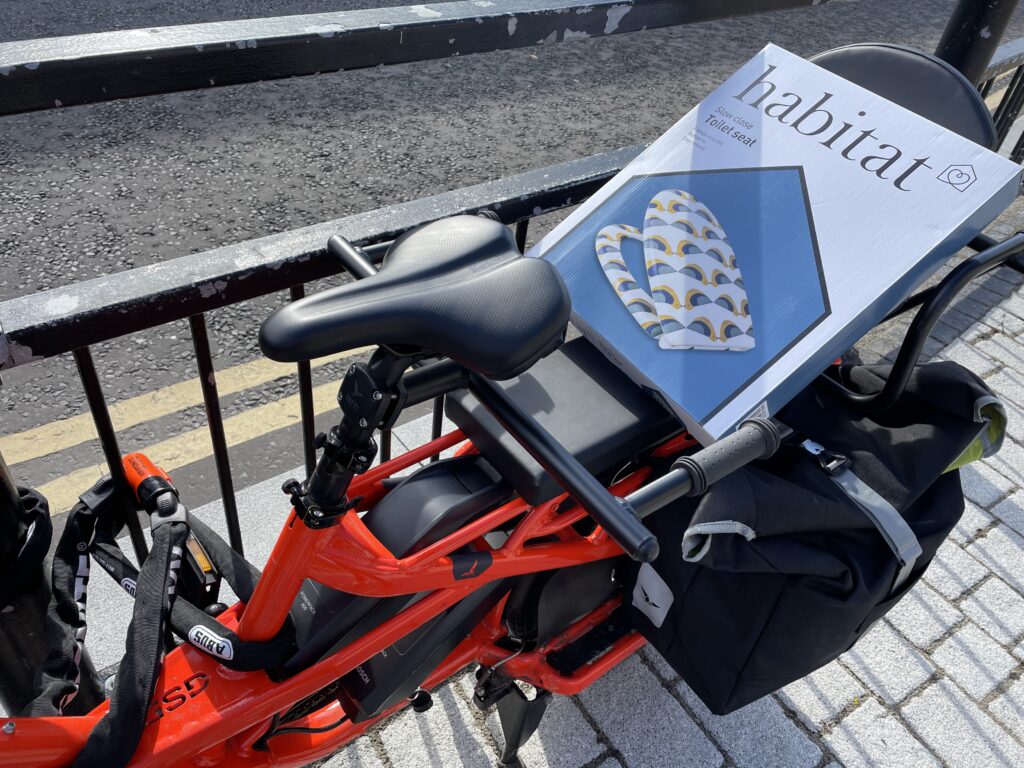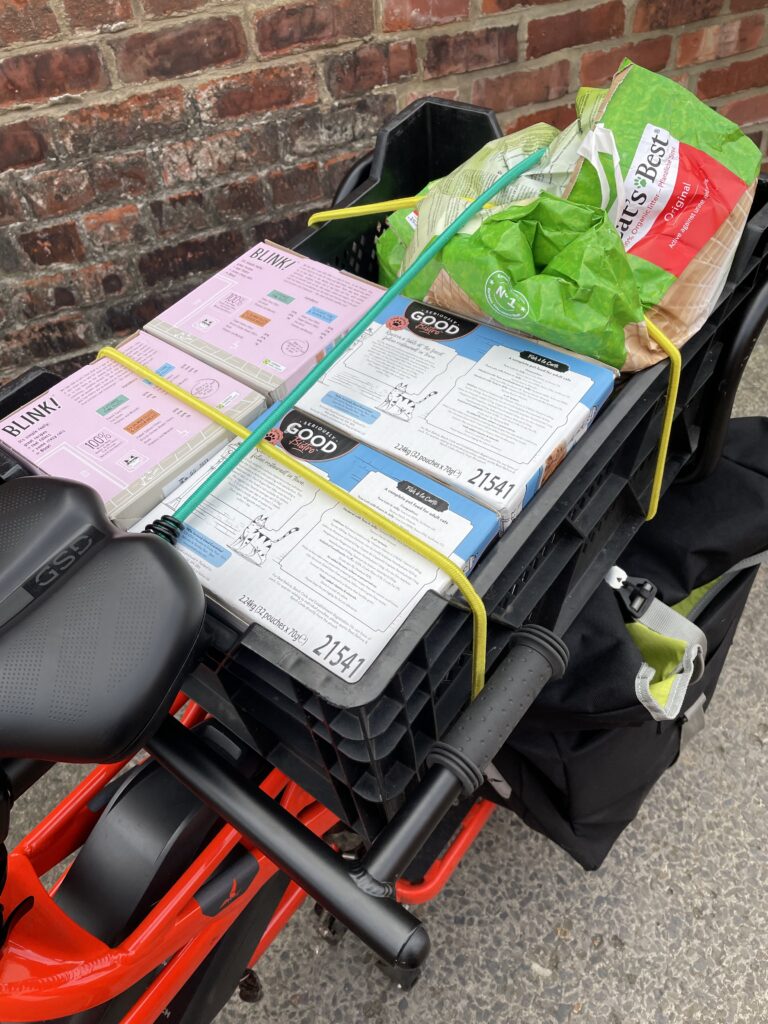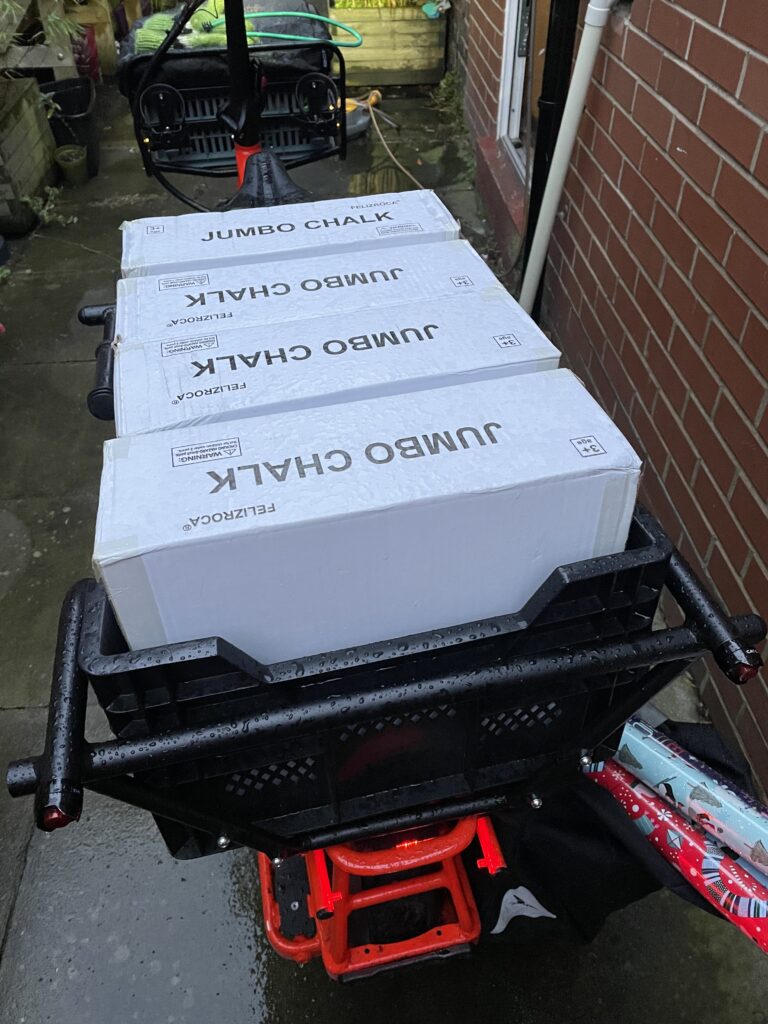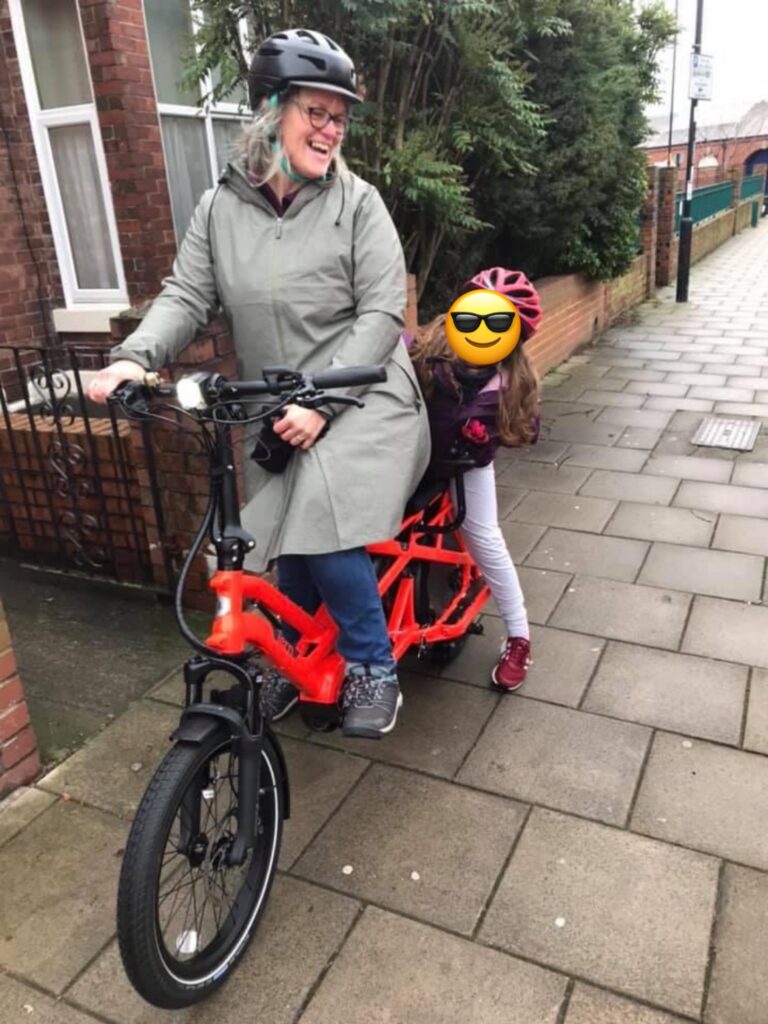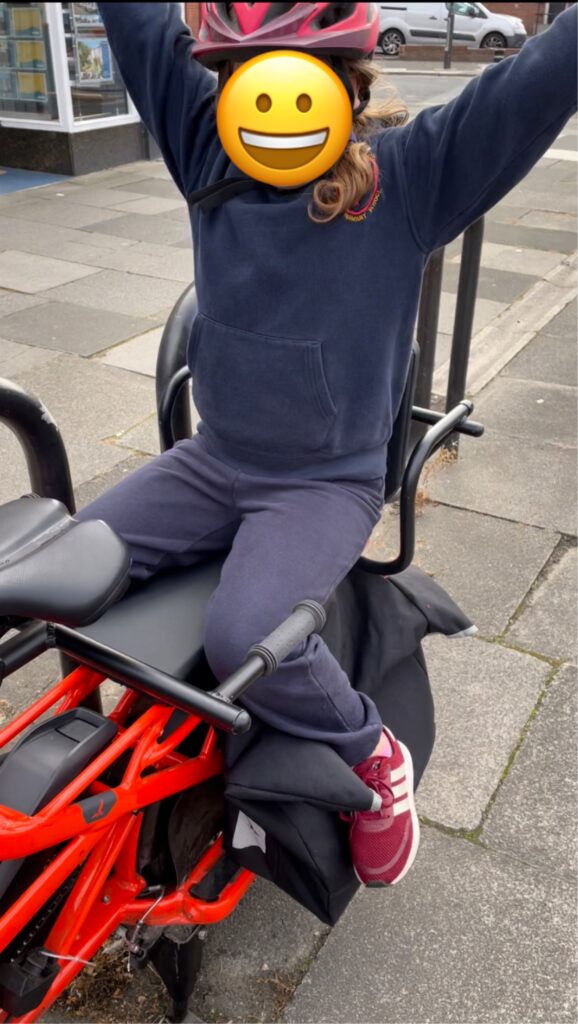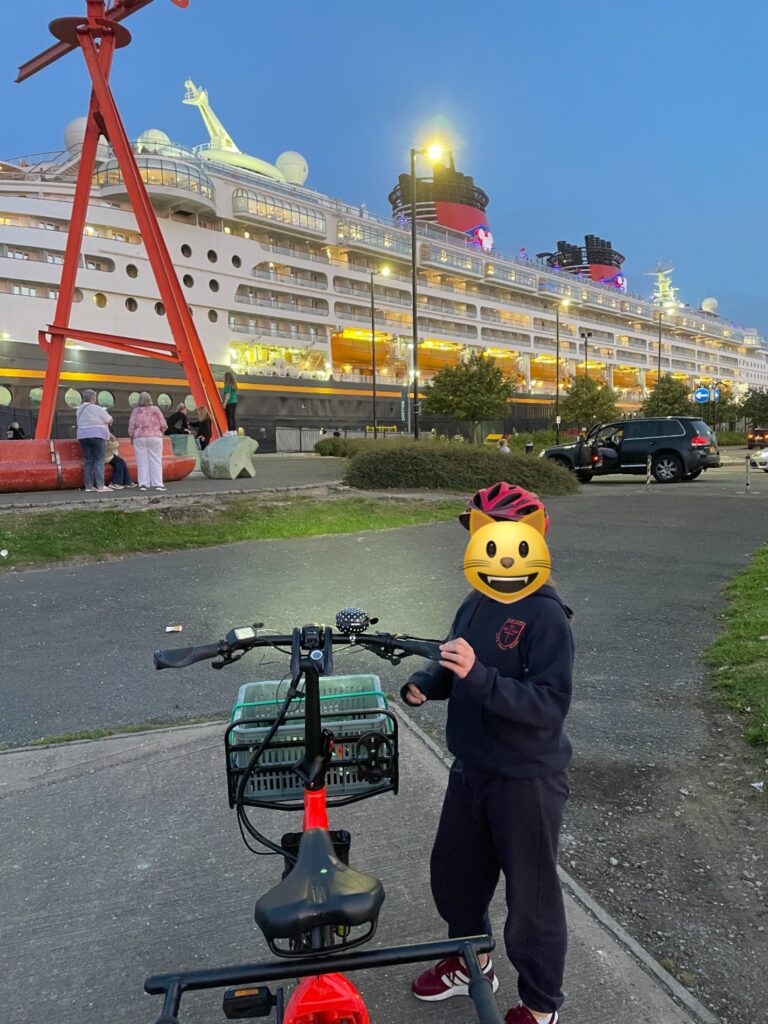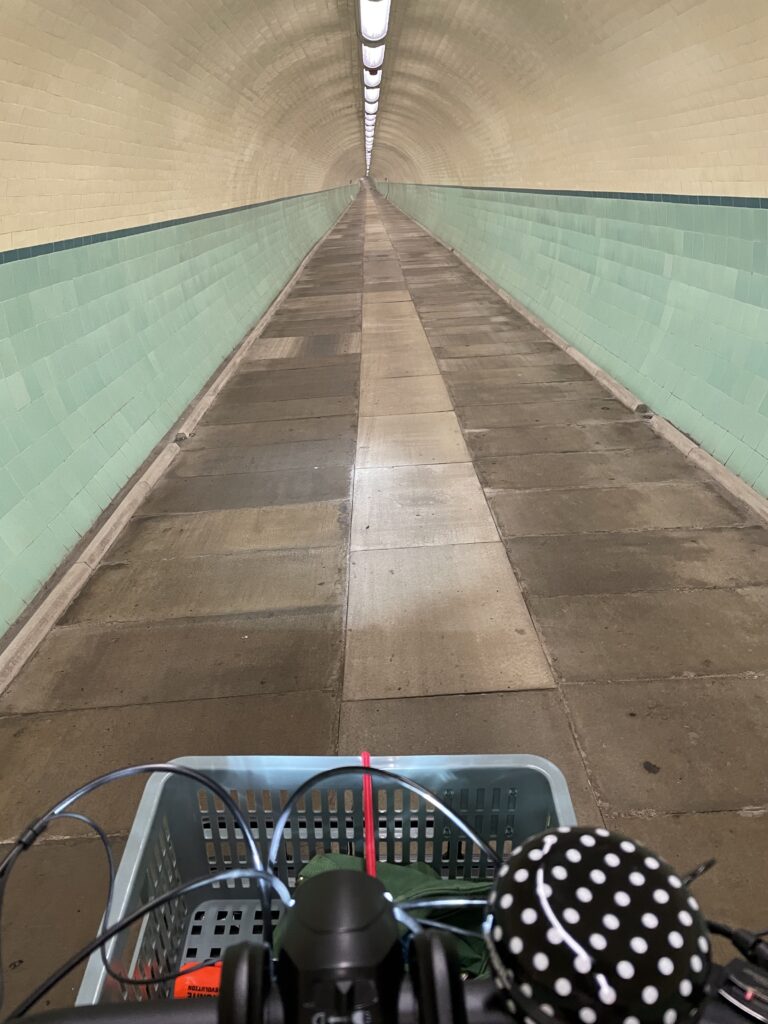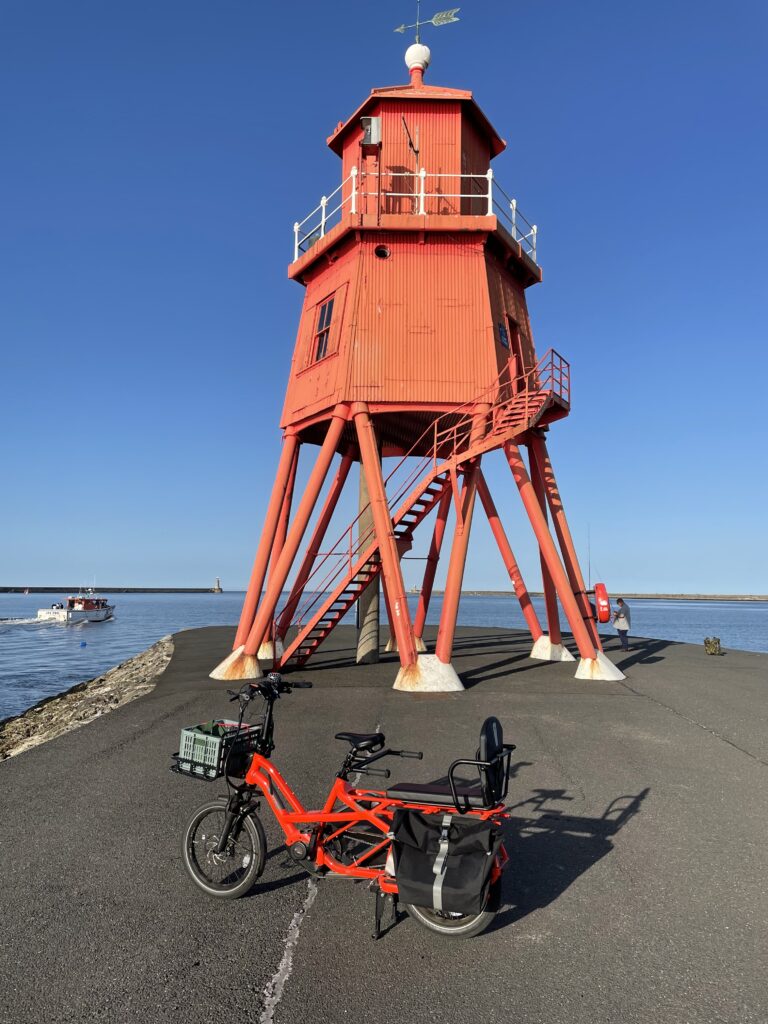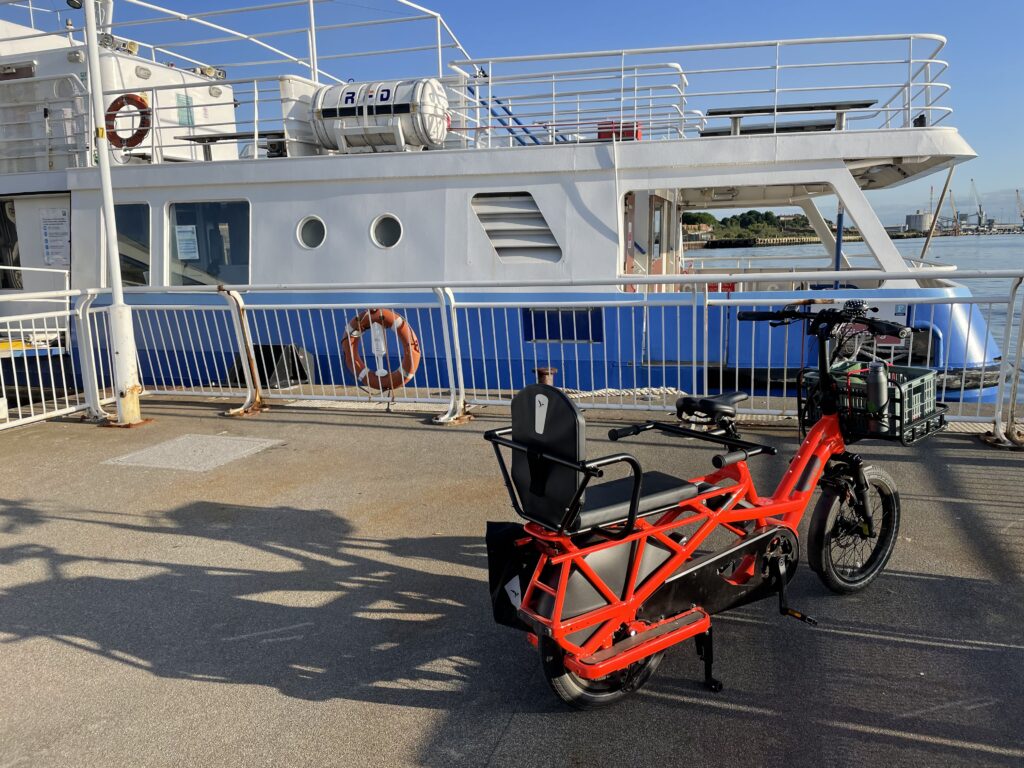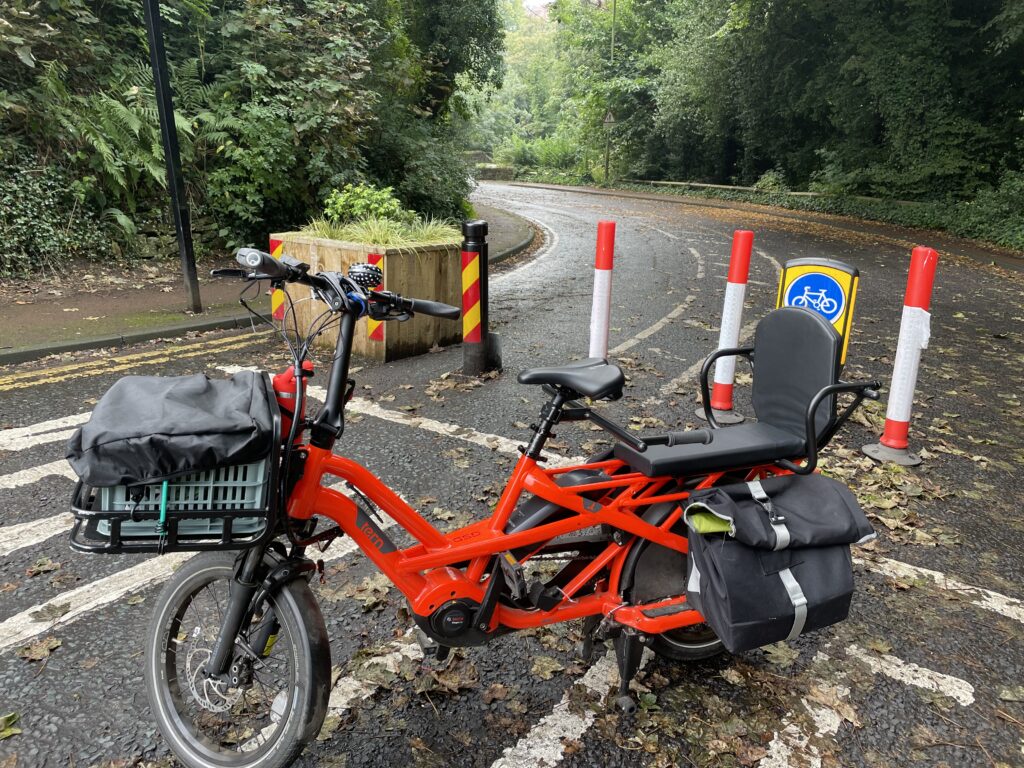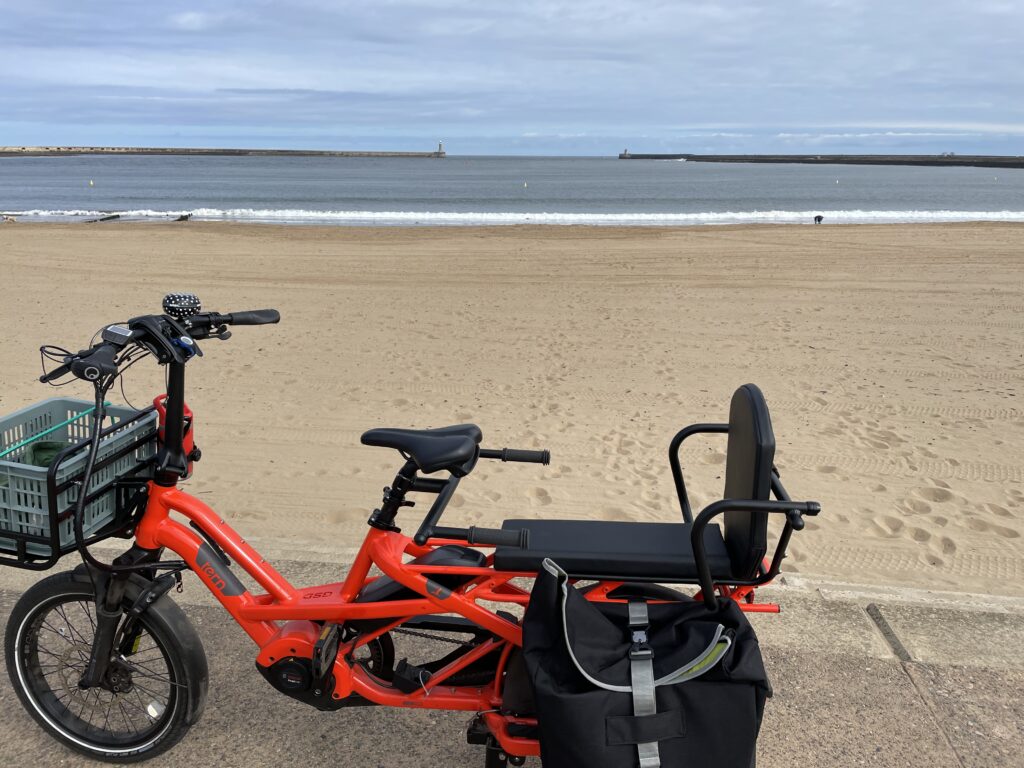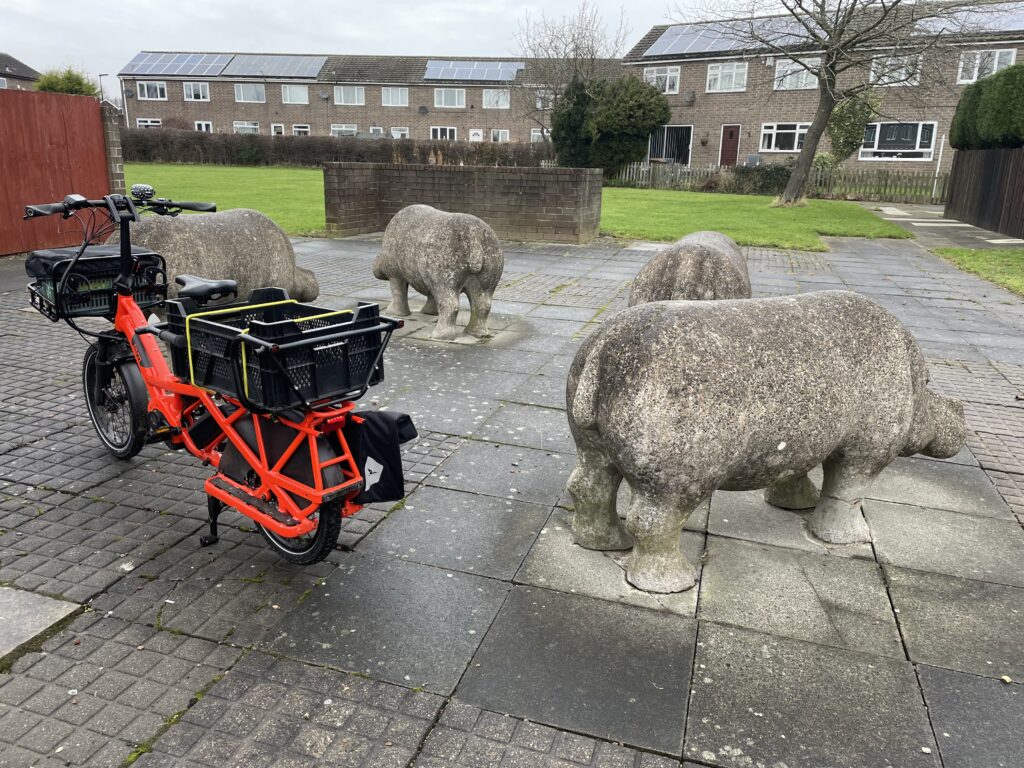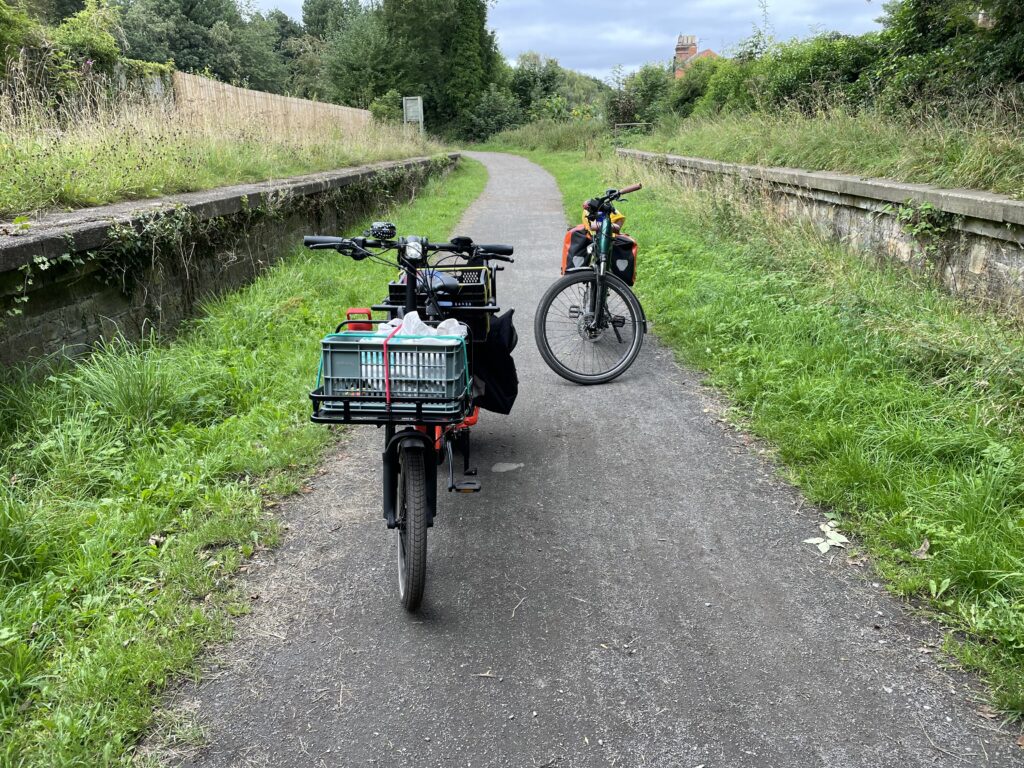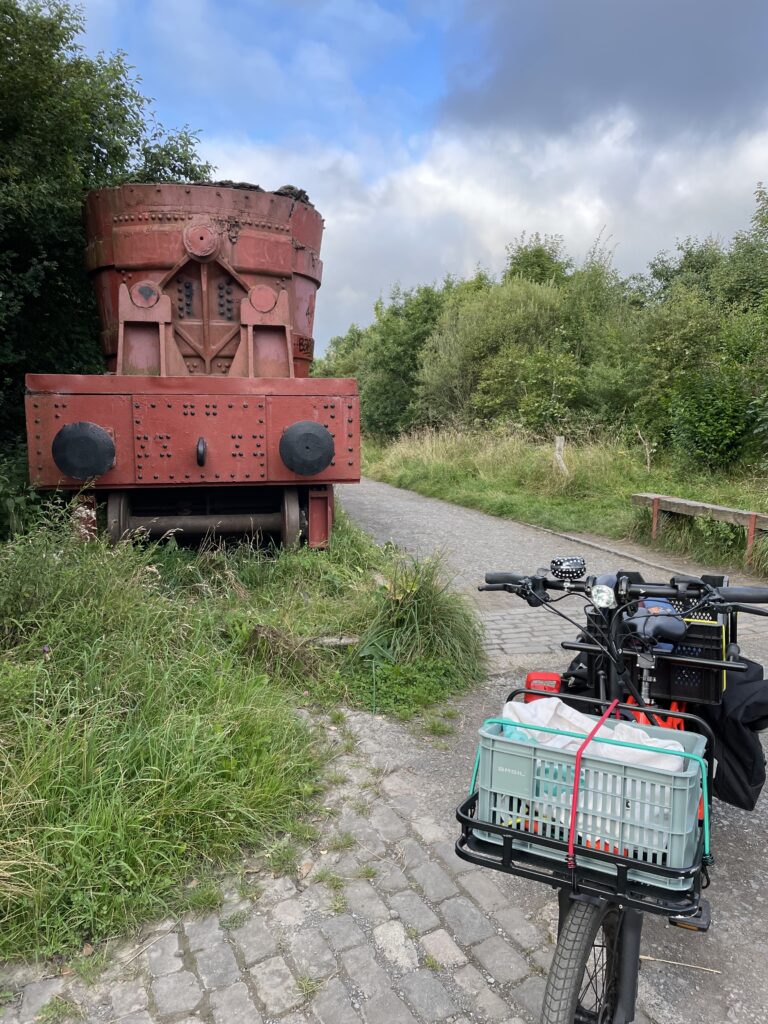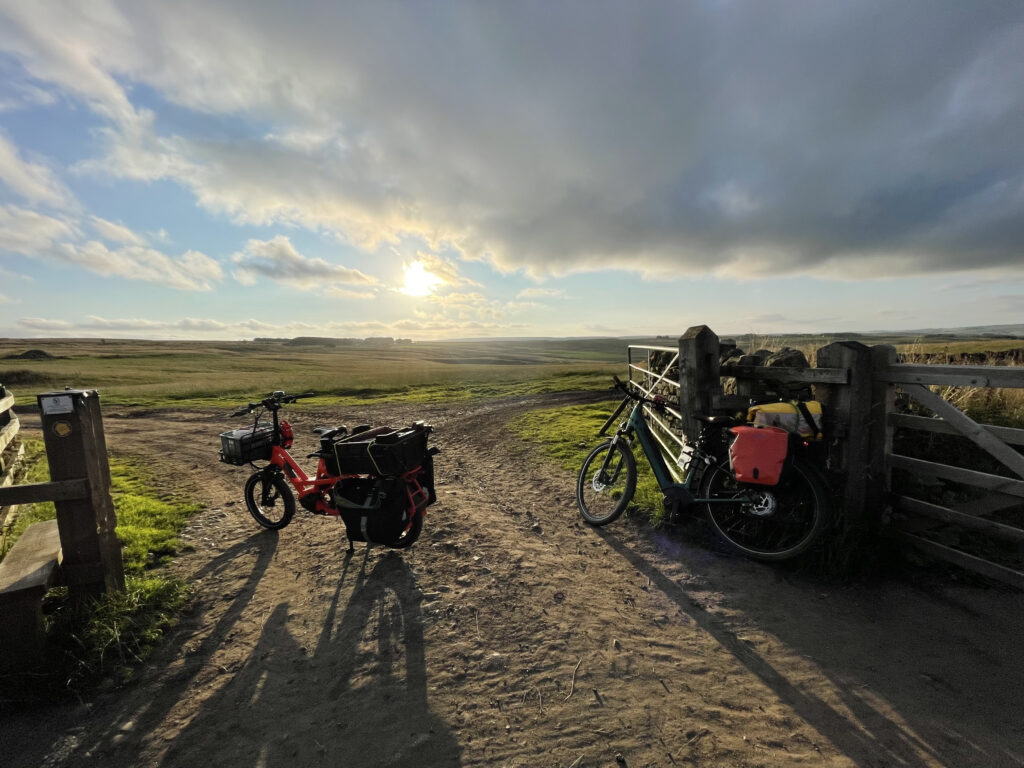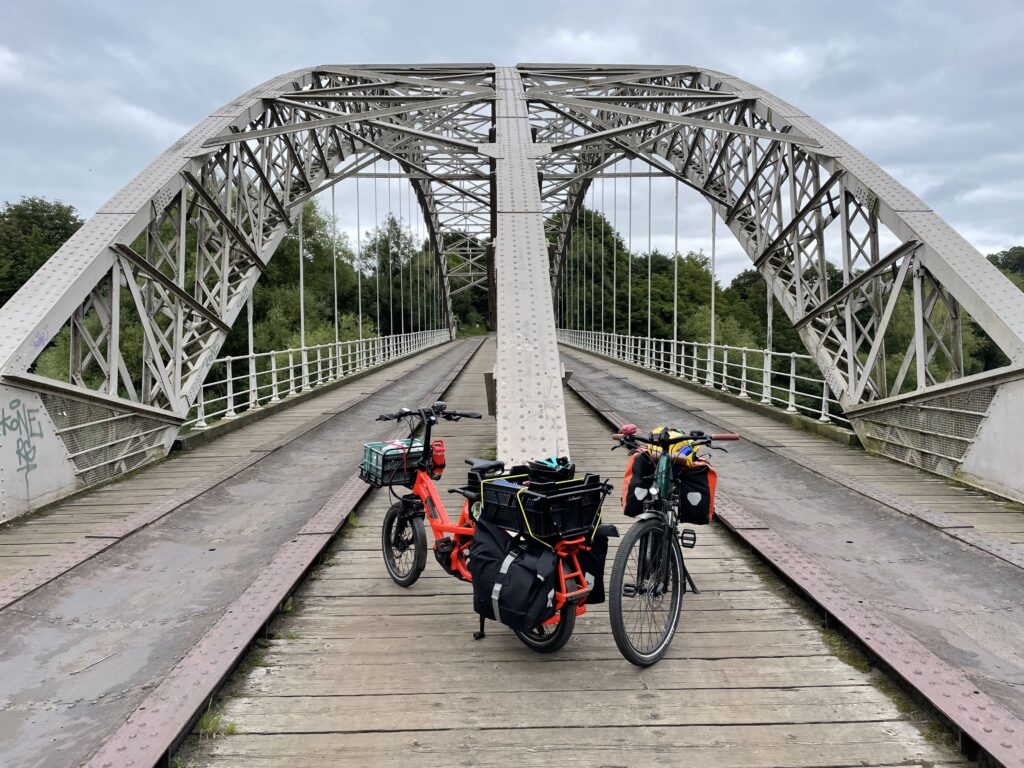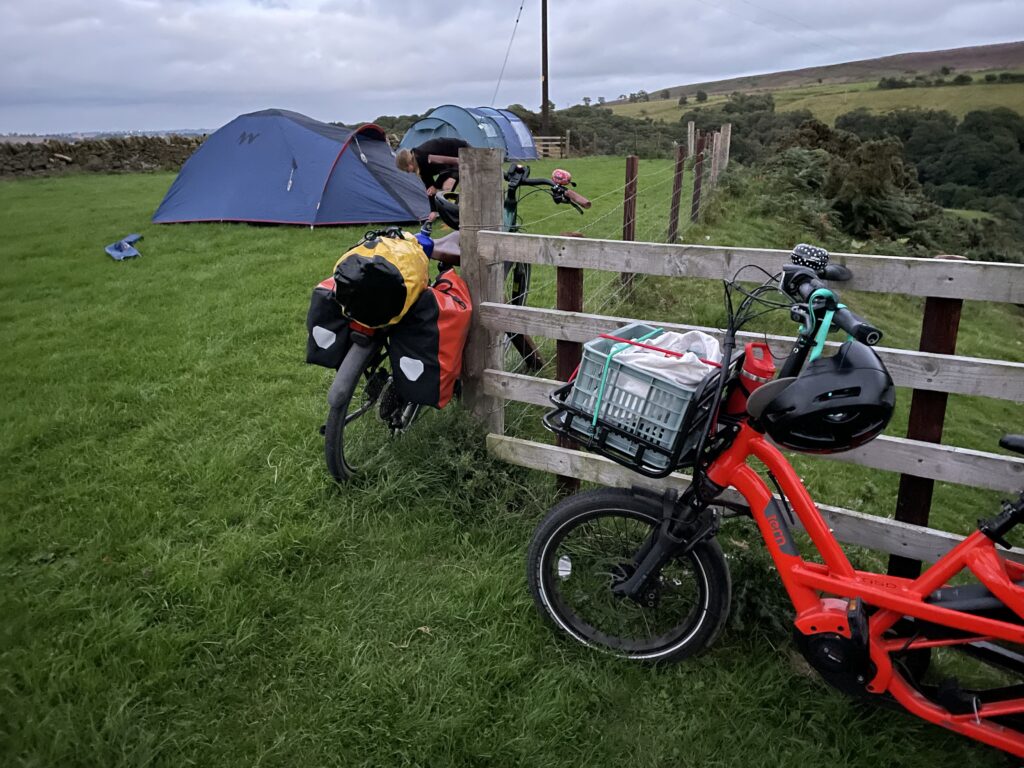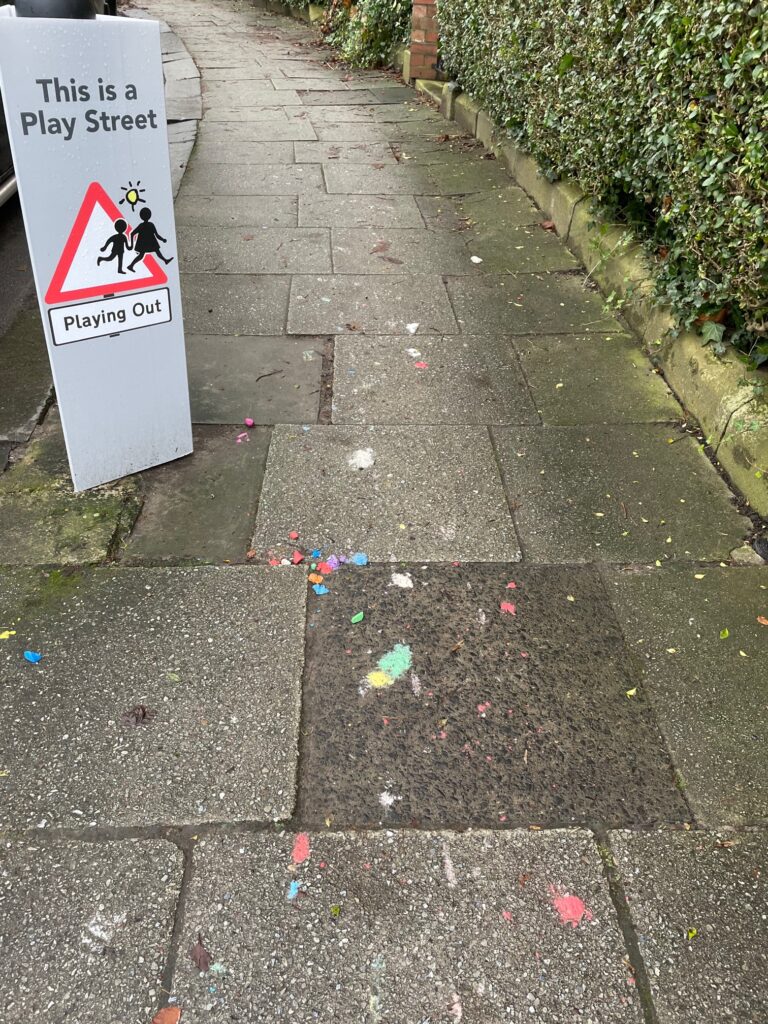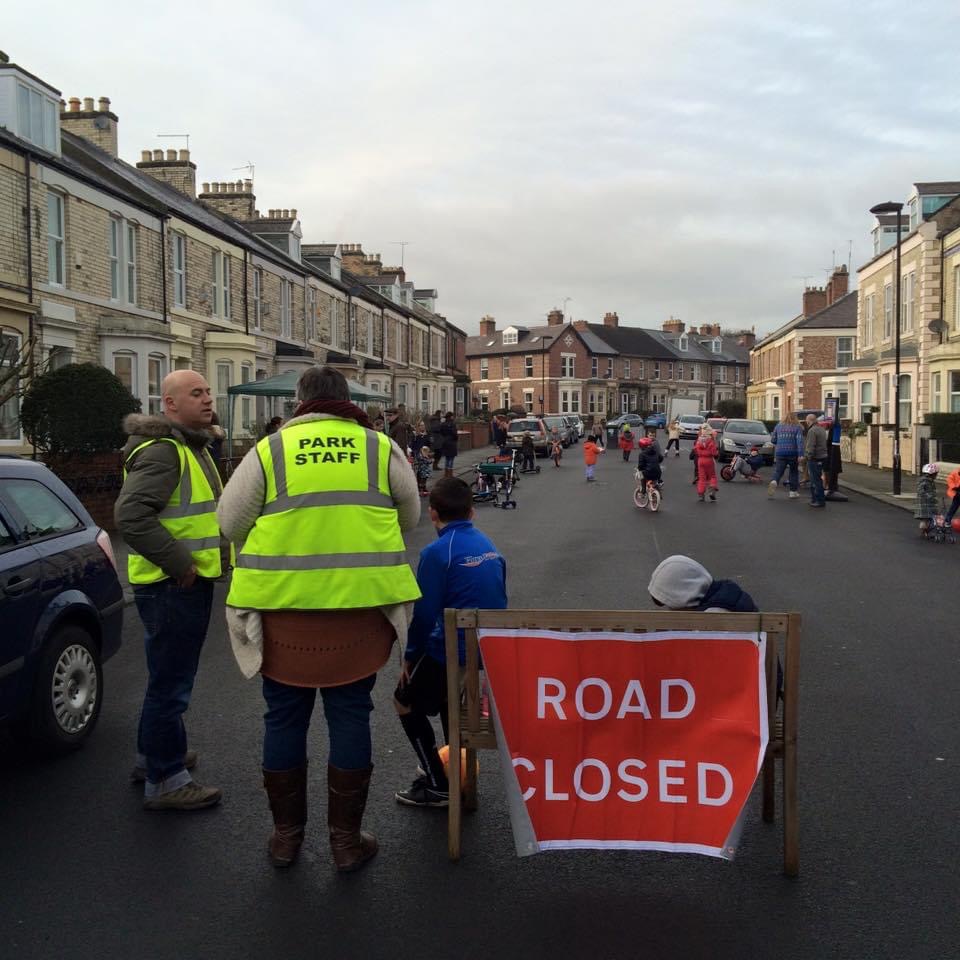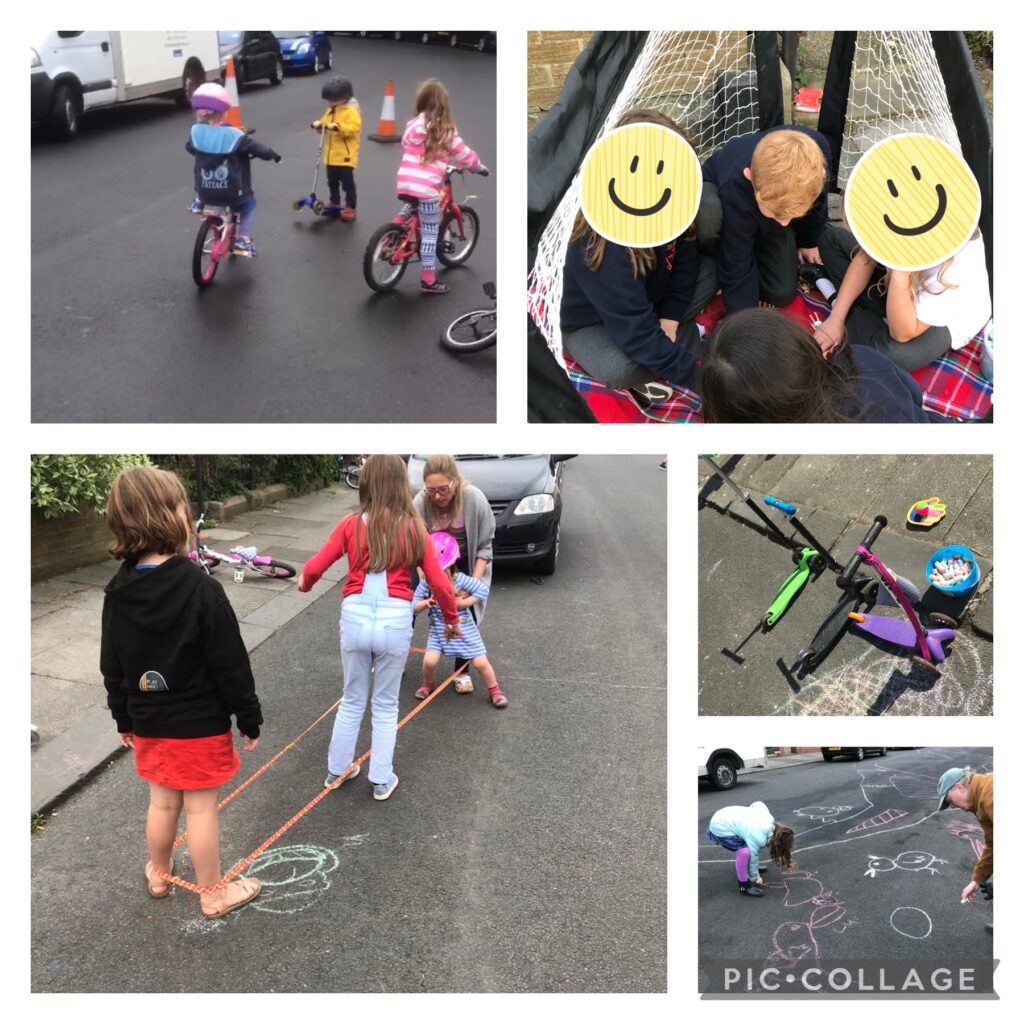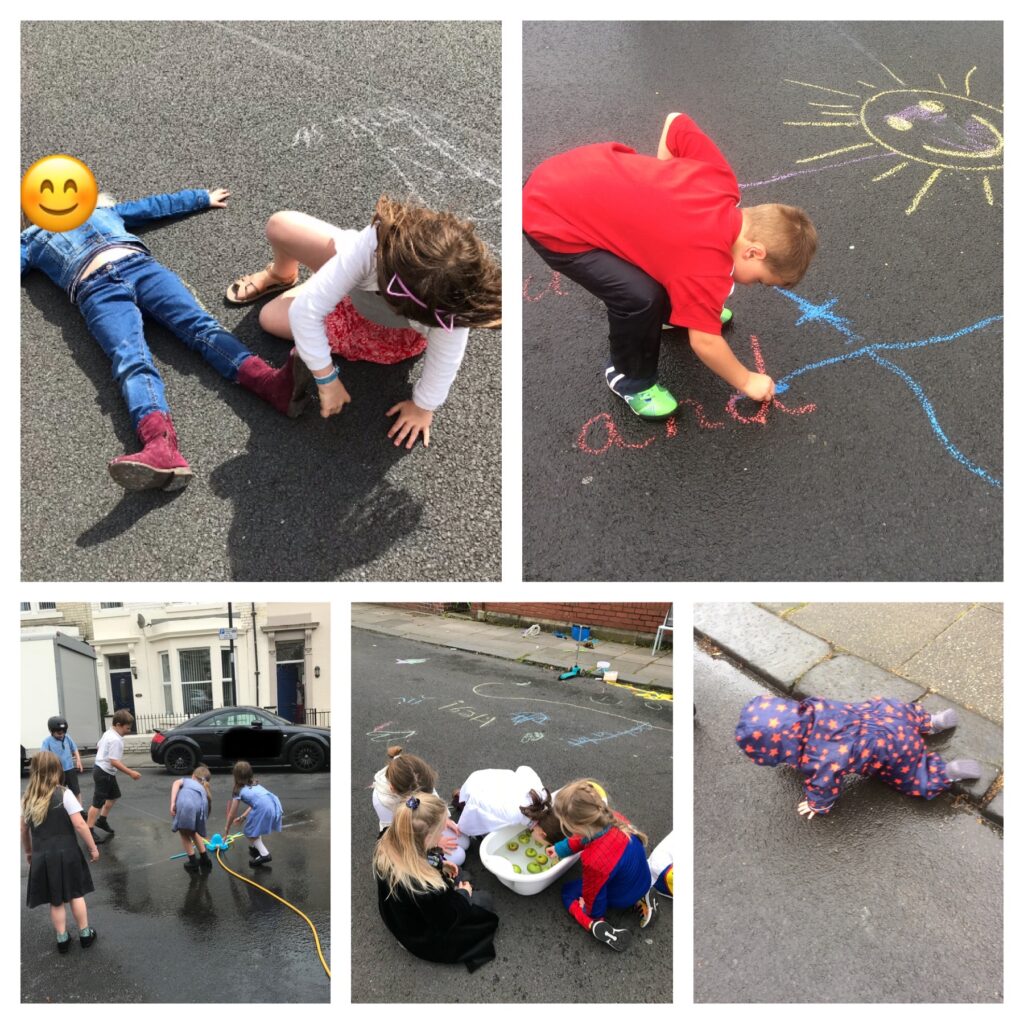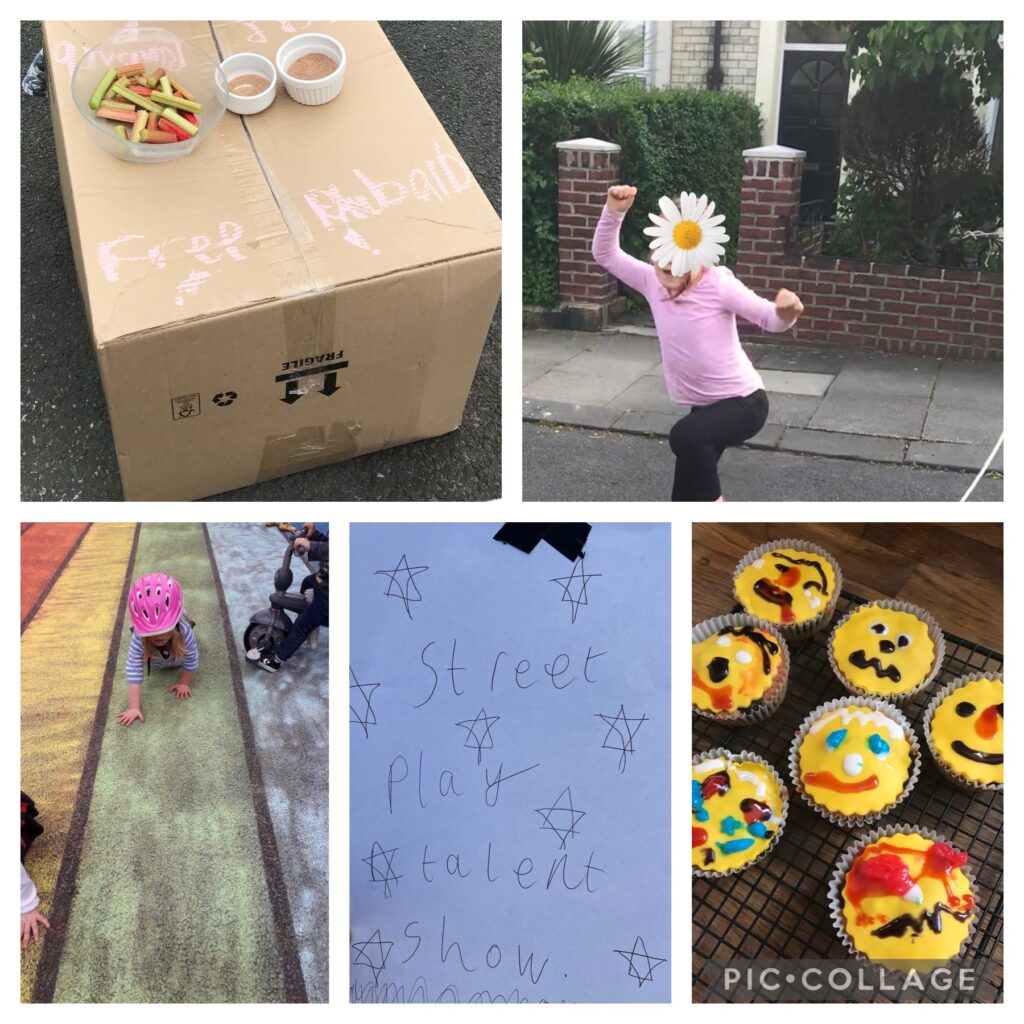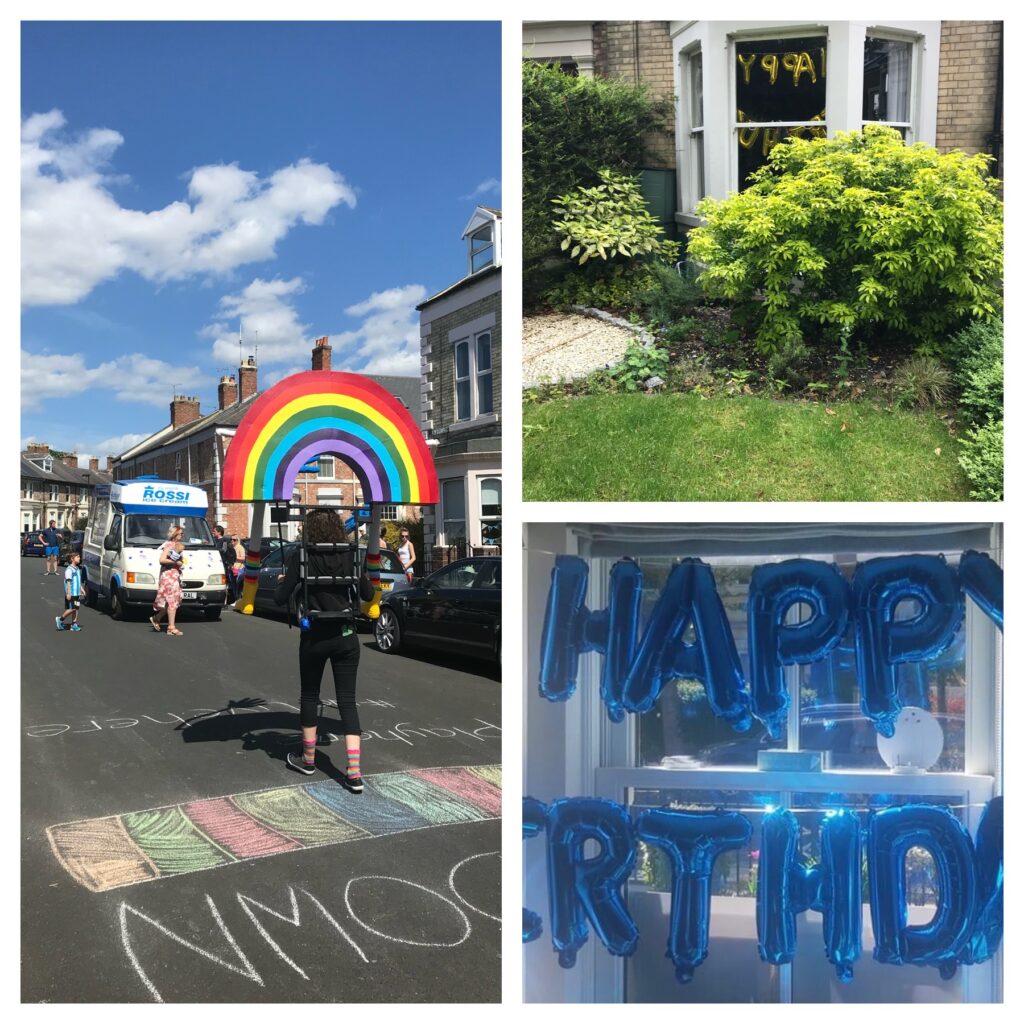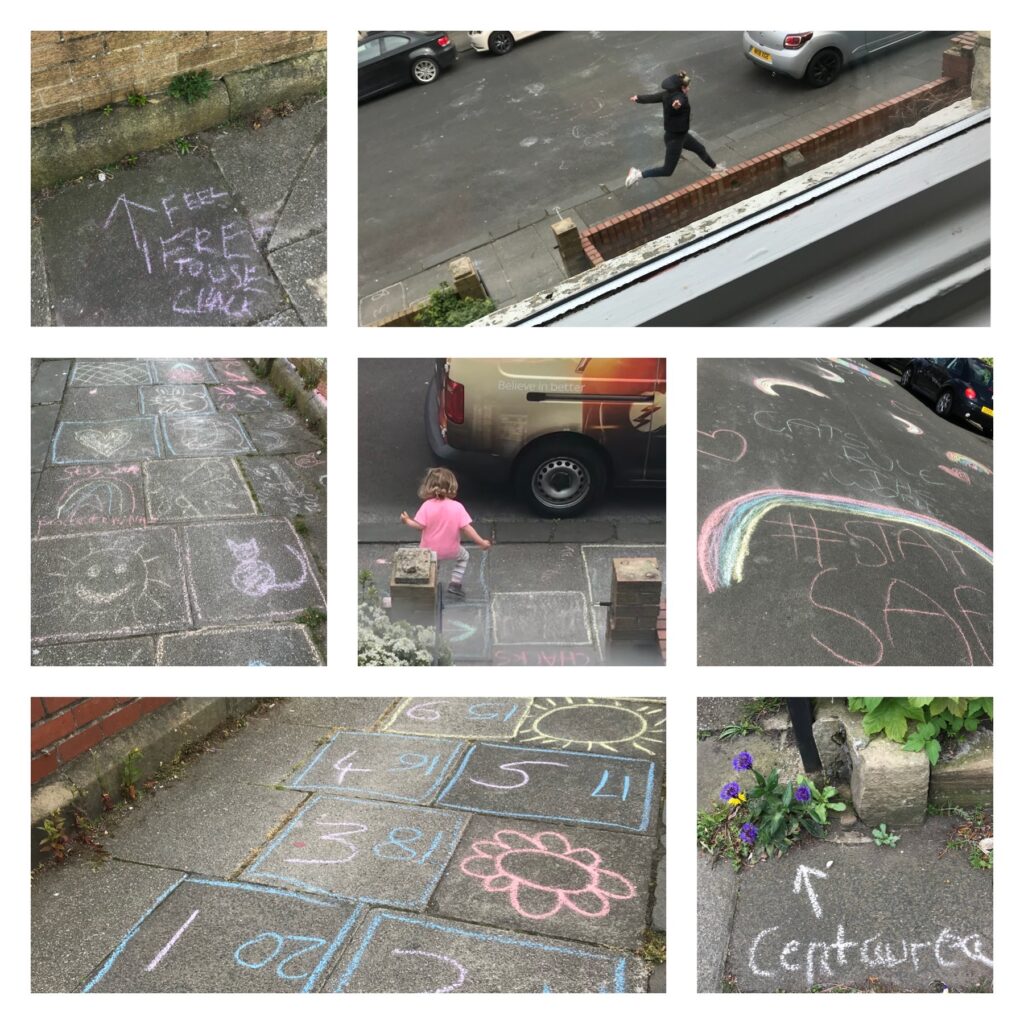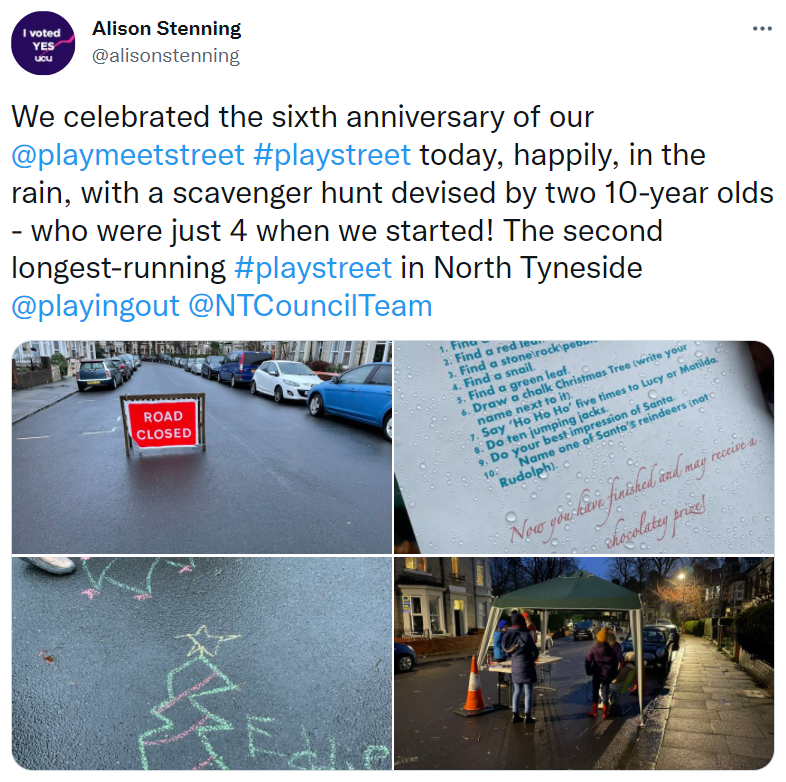I’ve just passed the 1000-mile marker on my Tern GSD, my beautiful, bright orange, e-cargo bike. I know 1000 miles isn’t much for a seasoned cyclist, used to 100-mile rides every weekend, but it’s quite a milestone for me – I even managed to coordinate passing it with a Christmas social cycle with friends, festooned with lights, and with my daughter on the back.
I’ve almost always owned a bike, and I’ve cycled in most of the different stages of my life, but if you’d suggested to me, say, before covid struck, that I’d be riding this much, and that cycling would be my primary form of transport I’d have been surprised. It’s been a fairly rapid transformation, if one that already had foundations.
I cycled as a child (as I reflect in this blog) and at university; in sixth form and at university, in Birmingham and in Newcastle, bikes were my primary form of transport (though I have almost no recollection of what my bikes were then, what they looked like). I’d cycle daily to campus, and cycle home in the dark, with a strong sense that this was safer than walking. And in Birmingham, I cycled a lot with friends on long(ish) rides to the south of the city, to pubs mostly, as you do in your 20s. I bought my first car in about 1998 and that probably marked a significant shift in my cycling habits.
I don’t think I owned a bike when I moved back to Newcastle (in 2003) but bought one in around 2008 from Edinburgh Cycles and started cycling into work, from Heaton, for a couple of years. I cycled a bit on the waggonways then too, but I never cycled to the shops or to friends’ houses. Then I got pregnant and moved to North Shields and stopped cycling routinely. My then partner cycled to work quite regularly and did quite a lot of weekend bike rides too, some of which I joined him on, but it always seemed like I was juggling too much (childcare, work, shopping, etc.) to manage to cycle too – given what I know now about cargo bikes, perhaps I’d have made a different decision. I do remember one friend getting a box bike for the nursery run, but couldn’t quite imagine doing it myself. I still cycled quite a lot on holidays; we always took our bikes on family holidays to Ireland and I regularly cycled there, exploring quiet lanes on my own, with my partner, and often with my daughter on the back of my bike.
I’ve never particularly liked driving and I certainly don’t love cars. My current car is an 18-year-old Fiesta which somehow manages to pass its MOT each year without costly repairs. But, for years, especially those with a young child, we defaulted to driving for most journeys (though never the school run).
Fast forward to March 2020, to home working, remote schooling, and the quieter streets of lockdown. My daughter and I took to cycling around the residential streets of North Shields, mostly feeling safe with the low levels of traffic. We started regularly cycling to her dad’s and did a few longer journeys, to see the piles of stones near St Mary’s Lighthouse and to the marina at Royal Quays, for example.
In July 2020, North Tyneside Council created a pop-up cycleway all along our seafront, from Tynemouth to Whitley Bay, a cycleway that became popularly known as the Sunrise Cycleway. This 3-mile route opened up so much, as we managed the first summer of covid and the ongoing need for social distancing. My daughter and I used the route a lot, sometimes with friends, cycling to Whitley Bay for an ice cream, or just getting about, shopping, visiting friends. And I used it even more on my own, probably 3 or 4 times a week, to get to friends’ houses, to shop on the temporarily-closed-to-motor-vehicles Park View, and just to get some exercise and fresh air, a break from working at home.
My old Edinburgh Cycles bike started to fall apart – the seat snapped off as I rode home one day on the Sunrise Cycleway, and then the gears went and it seemed to make more sense to buy a new bike than fork out for expensive new parts. So I bought a lovely and long-coveted Dutch-style bike and rode that around the coast, on errands, for fun, often when I’d otherwise have driven.
I was beginning to imagine that cycling could be a bigger part of my life, and that it could become my primary means of transport for the first time since my 20s.
I’d started idly investigating ebikes over the summer of 2020, partly because I was cycling so much more but also because, as I engaged in more and more campaigning around the Sunrise Cycleway and other temporary walking and cycling interventions, more people were talking about ebikes in my social (media) circles. The geography of my everyday life had shrunk during the pandemic, as it did for many; most of my journeys were very local, but some of them involved carrying a load of stuff (mostly signs and kit for the play streets I support through PlayMeetStreet North Tyneside; it had always felt wrong to deliver kit to play streets by car, when at their heart play streets promote car-free spaces), but also, of course, shopping and my 10 year old daughter. If I was going to cycle more and drive less, I had to think about longer distances and heavier loads. I knew that I’d be unlikely to commute the 16-mile round trip to work, when we returned to the office, on an acoustic bike as I hadn’t for over 10 years. I knew, especially, that I would rarely be able to face the homeward trip in bad weather and in the dark, at the end of a long working day. I also knew from experience that I often ‘trip chained’ on my journeys to work, either by car or by metro, to fit in other errands and other destinations. I figured an e-cargo bike might be the solution for my needs.
So I hired an bike (just a Raleigh Motus at this stage) from Tynemouth’s Ride Electric for a month and I used it a lot – to travel to work occasionally, to shop, to take things to the dry cleaners, to go on little adventures, exploring Tyneside, travelling further by bike than I had for years. I loved the roaming distance it gave me, that I could just keep going (as long as my battery did).
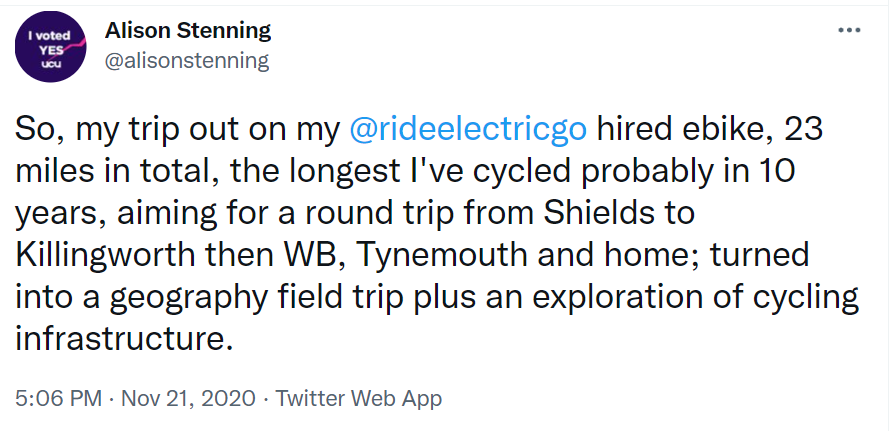
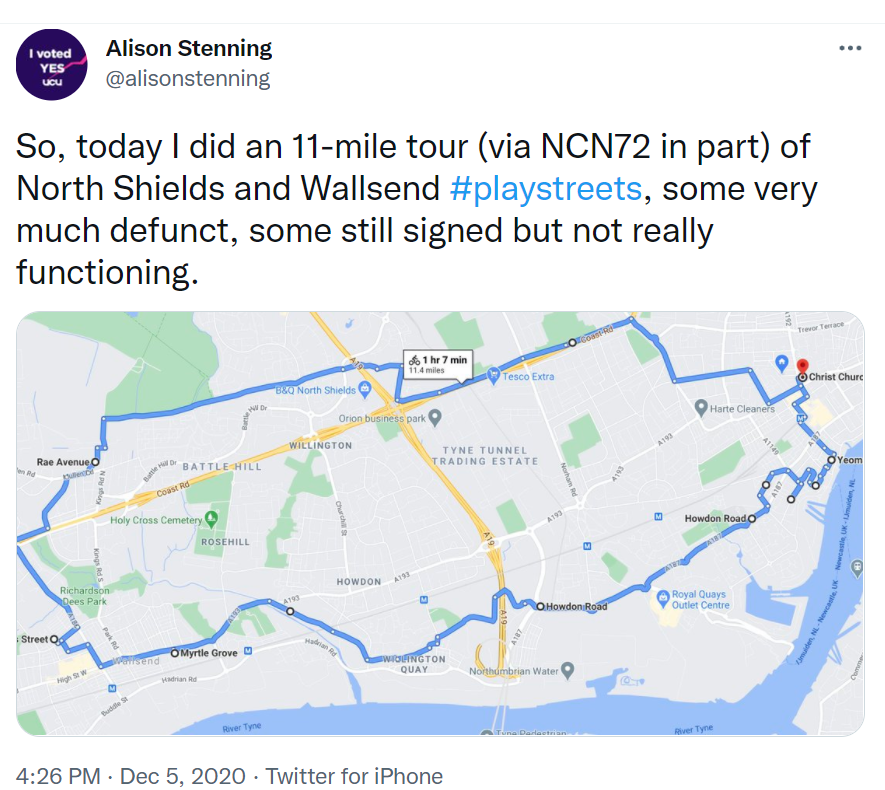
These experiences convinced me that I’d use an ebike, that I’d enjoy it, and that an ebike would open up spaces and activities for me. I’d been eyeing up Tern GSD and other long-tail e-cargo bikes, wondering if, as well as moving me, I might use a bike like this to move my daughter and other ‘cargo’.
Tern GSD have some impressive promo films, imagining a seamless life of childcare, shopping and fun (not much work!) and I was tentatively persuaded – but any ebike is a big purchase and the Tern GSD all the more so (though much less than a car, as I always tell curious passers-by).
In late January, Craig from Ride Electric rang me to tell me he could get me a GSD the following week. I was slightly freaked out; I’d imagined taking months to make the decision carefully and cautiously. But I looked at the finances, talked to a lot of people, and said yes.
On 3rd February, I became the proud owner of a ‘tabasco’ (orange) Tern GSD.
I loved it immediately. Even on a cold, wet February day, cycling felt like a breeze and I was confident that I’d manage – and enjoy – longer and longer distances. I had the Captain’s Chair installed for my daughter (which can be swapped out for a crate for cargo) and my Tern GSD adventures began.
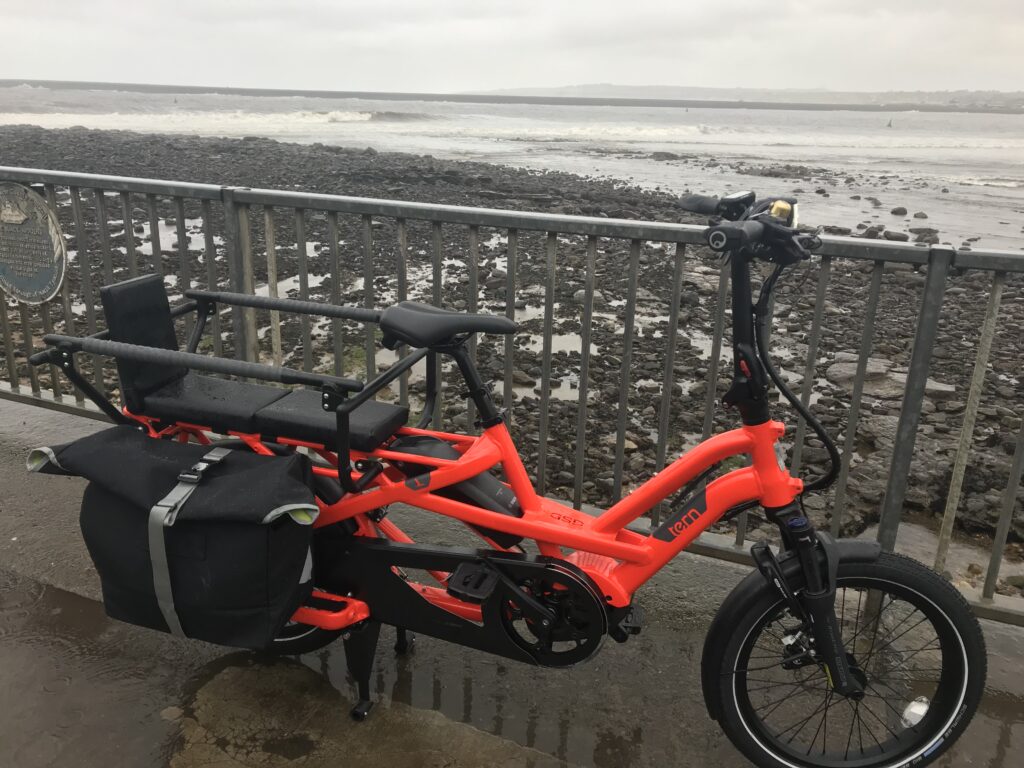
I’ve used it for everything I expected and much more. My 1000 miles have been racked up by cargo trips – carrying weekly shops, pet food, charity collections, plants, bulk purchases of pavement chalk, a toilet seat and a bin, and many, many sets of Road Closed signs and kit for play streets.
By trips with my daughter, sometimes getting her places which were too far (or too dangerous) for her to ride her own bike, trips we’d otherwise have driven – to friends, to her dad’s, to and from after-school activities – and sometimes just for fun, to explore the streets around us, to see the sea, to experience the joy of the Tyne Pedestrian and Cycle Tunnel.
By longer rides, on my own and with friends, to explore more and more of Tyneside (and Northumberland and Wearside), to get some exercise, to enjoy the pleasure and thrill of cycling (sometimes despite our ropey cycling infrastructure). I’ve been to Sunderland, Washington, Killingworth, up and down the North Tyneside coast hundreds of times, into Newcastle and around, racking up the local miles.
And, with a friend, I did my longest ever cycling trip and my first ever cycle-camping trip, taking in over 80 miles on a round trip up the Derwent valley to the north Pennines, back to the Tyne, and home to North Shields, loading all we needed onto my GSD (and stopping occasionally to recharge my battery – I’ve since invested in a second battery – nothing stops me now).
And, since September, I’ve been commuting, to the centre of Newcastle, at least twice a week, a 16-mile round trip that’s quicker and more reliable than the metro, and probably the car. It takes me 38 minutes, door-to-door, give or take a minute or two. I’ve done it all weathers, and have just got winter tyres fitted so that I can carry on. On the one occasion I had to take the metro to work (as Storm Barra approached), I got colder standing on the metro platform and wetter walking between work and the metro than I ever have on the GSD – waterproofs do their job. I love the commute – I love that it’s predictable, but also that I’m in the world. I witness the seasons change, I see sunsets, I meet other cyclists, I enjoy the movement. I don’t love the Coast Road cycle path, the primary route from North Tyneside to Newcastle, but that’s another story.
Oh, and I brought my Christmas tree home by bike, because I could and because it was fun.

So that’s 1000 miles. Interestingly, it took me seven months to do the first 500 and just 3 to do the second 500, mostly as I’ve been racking up the miles on my commute. I wonder how many miles I’ll have done by the first anniversary of my bike purchase in February. I’m tempted to say I’ll aim for 1500 miles by then, but it’s winter and it’s Christmas, so I make no promises.
I’ve done everything I expected to by bike, and more. I didn’t know how I’d find cycling in miserable weather, but it’s genuinely OK. And I never feel too tired to cycle home at the end of a working day; I just boost the power up to turbo. Even on turbo, I’m getting more exercise and more fresh air, and more contact with the world around me, than I have for years. I’m much more profoundly connected to my neighbourhood, town and region than I was before (and being a geographer, this has always been something I have striven for).
There are real frustrations around infrastructure – some of it is not only dreadful but dangerous – and my experiences have reinforced my commitment to campaigning, and I’m holding on to a slightly forlorn hope that things will get better. But I’ve loved planning routes, using maps and street view, and get a surprising amount of joy in finding the cut-throughs, alleyways and short-cuts that I’ve spotted on a map – and through which cars can never travel.
The plan is to give up my car altogether at the end of January, perhaps to mark my GSD anniversary. I use it maybe one or twice a fortnight at the moment; the rest of the time it’s parked up, taking up space on my overcrowded road. I’ve joined a car club and I’ll still use a car occasionally, but mostly I’ll make do, either with my bike, or with public transport, or the occasional taxi.
Like I said at the beginning, it’s been a fairly rapid ‘modal shift’ for me, albeit one with long foundations. What have been the key ingredients? Certainly, being encouraged to cycle as a child and keeping that up through early adulthood. After that, hmm, believing that streets are for people and getting involved in movements that campaigned around this, and consequently getting to know more people who made these choices. But beyond these quite abstract ideas, perhaps the most important factors were the quiet streets of lockdown and North Tyneside’s Sunset Cycleway, which reminded me how much I enjoyed cycling and how enabling it is, and the rise of ebikes, which are still more enabling, for longer distances and heavier loads. (This is what I said in answer to this question on Twitter; the other answers in the thread are fascinating.)
So, that’s it. That’s the story of my 1000 miles. And the moral – ride a bike, ride it more, fork out for the fancy one if it’ll help you do what you need (it’s always going to be considerably cheaper than a car) – you’ll save money, be healthier, and get to know your world more. What’s not to like?


